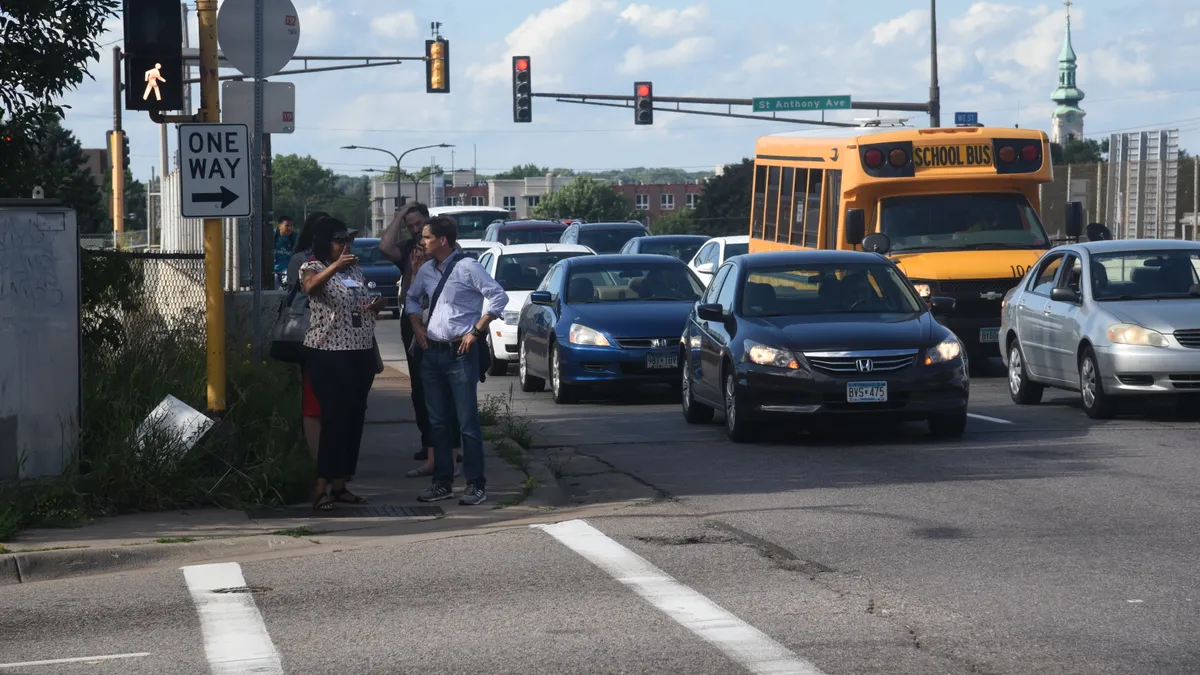Dive Brief:
- The number of people struck and killed by drivers has increased 45% nationwide over the past decade, according to Smart Growth America's (SGA) Dangerous by Design report, which urges policymakers to curb the problem by making streets safer for all users in a bid to reduce vehicle speeds.
- SGA reports that 53,435 pedestrians were killed between 2010 and 2019, with the equivalent of at least 17 people killed a day in 2019. And the Orlando, FL metropolitan area was found to be the most dangerous for pedestrians, followed by Bakersfield, CA and Memphis, TN.
- Of those killed nationwide, Black people were struck and killed by drivers at an 82% higher rate than White, non-Hispanic people in the U.S. And the fatality rate for people walking in the lowest income neighborhoods was nearly twice that of middle-income census tracts and almost three times that of neighborhoods with higher levels of income.
Dive Insight:
The report paints a troubling picture of pedestrian safety in the United States, a trend the Governors Highway Safety Association (GHSA) has continually highlighted, having noted last year that pedestrian deaths hit their highest rate since 1988. Earlier this month the National Safety Council (NSC) also shared that vehicle fatalities have reached their highest point since 2007.
State and local governments are to blame for failing to rethink street design, according to SGA Transportation Director Beth Osborne, and for prioritizing the speeds at which cars can travel over the safety of other street users.
"This is truly something that has been on the wrong course for a long time with no attempt to intervene," Osborne said during a webinar hosted by SGA on Tuesday.
Of the 20 most dangerous metropolitan areas, nine are in Florida, according to the report. And 84 of the 100 metropolitan areas surveyed were found to have gotten more dangerous for pedestrians, according to the SGA Pedestrian Danger Index (PDI), which measures how deadly it is for people to walk based on the number of walkers killed by drivers.
Prioritizing safety over street speeds does not just mean lowering speed limits, according to Osborne. It requires changes like narrower travel lanes, more crosswalks, increased vegetation on the sides of streets and signalized crosswalks, while also avoiding broad curves at intersections and wide travel lanes. Shorter distances between intersections can also prevent drivers from speeding in an attempt to get through stoplights.
Recent reports have also highlighted the troubling trend of drivers traveling at faster, more dangerous speeds during the pandemic. As downtown traffic volumes fell an average of 44% in 2020, drivers increased their speeds in those areas by up to 42%.
That trend "underscores the nation's persistent failure to prioritize the safety of our roads," Osborne said. "When they became emptier, they became more deadly because the design of our roads encourages people to drive quickly. And without congestion, there's nothing to stop it."
Law enforcement has also been largely "ineffectual" at getting people to slow down, according to the report, which points to issues like poor education campaigns and victim-blaming. Transportation experts have also pointed to the added danger of police stops for Black and Latinx drivers.
Other road safety experts said enforcement is a necessary tool in the toolbox, and safety cannot be left completely up to street design to reduce road deaths.
"All highway safety approaches — infrastructure improvements, traffic enforcement, community engagement and others — are needed to address the many highway safety threats that all road users face every day," GHSA Executive Director Jonathan Adkins said in a statement provided to Smart Cities Dive. "No single approach will be completely effective. Even as we work towards better roadway planning and speed control, we will still need other safety countermeasures to fill the gap as we bring the built environment nationwide up to what it should be."
There is evidence that federal lawmakers are looking to tackle the issue of street safety nationally. U.S. Sen. Ed Markey, D-MA, and Rep. Steve Cohen, D-TN, reintroduced the Complete Streets Act late last month, a bill that would require states to set aside a portion of federal highway funding to create a Complete Streets grant program for eligible projects. The pair previously introduced the bill in 2019 but made no progress on passage.
Osborne said while it is encouraging to see legislators trying to tackle safety at the federal level, state and local transportation and public works departments already have the ability to do things differently.
"It is fully within their control to change their approach today," Osborne said. "The reason we keep engaging the federal government is due to the lack of willingness in so many transportation and public works agencies."












